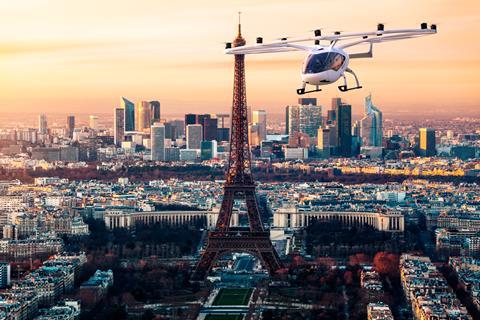Paying passengers are likely to be flying in electric-powered air taxis in Europe by the middle of the decade, the bloc’s chief aviation safety regulator believes, but fully autonomous operations are likely to be some way off.
Presenting the findings of a study into public attitudes to urban air mobility (UAM) services on 19 May, Patrick Ky, executive director of the European Union Aviation Safety Agency (EASA), said that considering the “good progress being made” he believes that “commercial use” of such aircraft would likely begin in the 2024-2025 timeframe.

“We are in the process of certifying some of the vehicles that will be used for UAM and the certification target which we think is realistic is 2024,” he says.
“We might be late, we might be early, but we think the vehicles themselves can be certified by this date.”
Europe-based companies including Lilium and Volocopter are looking to bring their electric vertical take-off and landing (eVTOL) aircraft to market in that timeframe.
Ky anticpates the certification of each vehicle taking around four to five years, although the unfamiliarity of some start-up companies with EASA processes may delay the approval of their aircraft, he adds.
Around a dozen projects have applied for EASA certification, including several for the unmanned transport of goods – so-called delivery drones.
However, the time required to certify these vehicles is likely to be shorter, says Ky, and EASA is likely to accept “lower safety targets for goods drones”, particularly if they are to be flown over unpopulated areas.
While cargo drones will be unmanned, Ky thinks it will be several years before passenger flights will be conducted without a pilot on board.
Initial work has been conducted with UAM developers to consider the potential conditions to permit autonomous flights, says Ky, “but we have not gone too far”.
He says that “a lot of thinking” is required on the topic, notably around the integration of such services into the airspace and other safety considerations.
“There is no exact timeframe; it will take at least five more years to arrive at autonomous transport for air taxis.”
Initially, pilots of UAM vehicles will be required to hold a commercial pilot licence – whether for fixed- or rotary-wing aircraft – but this will change as technology improves, says Maria Algar Ruiz, drones programme manager at EASA.
“As soon as the level of autonomy increases and we learn more about how these eVTOLs fly in urban environments we will start developing a new category of licence for this type of vehicle,” she says.
To gain a better understanding of public attitudes to this new sector, EASA surveyed nearly 4,000 people in six cities earlier this year: Barcelona, Budapest, Hamburg, Milan, Paris, and the Oresund region on the border of Denmark and Sweden which includes Copenhagen.
Over 80% of those surveyed had a positive attitude to UAM activities, with 71% ready to try out such services. Respondents’ main concerns were around safety – both of the vehicles themselves and their susceptibility to cyber attack – the environmental impact of operations and potential noise pollution.
Ky says the agency will use the findings to shape its regulations “in line with the perceptions and expectations of citizens.”
He notes that the survey results showed that the public expects passenger operations to be as safe as a regular commercial air transport. “It is something that we find a challenging target, but we think we can work with that,” he says.
EASA will not be responsible for licensing individual operators or determining permitted routes or the location of ground infrastructure, but Ky says the results of the study should help to guide the decision making of national or local authorities.
Respondents to the survey saw the most benefits to society from the introduction of emergency medical services operations or congestion-busting inter-city flights, provided these were at an affordable price.


























